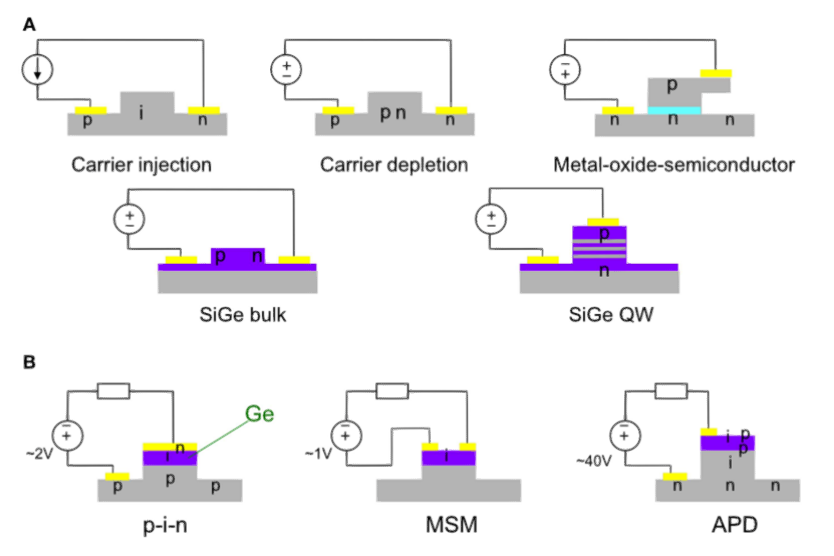Silicon photonics active element
Photonics active components refer specifically to intentionally designed dynamic interactions between light and matter. A typical active component of photonics is an optical modulator. All current silicon-based optical modulators are based on the plasma free carrier effect. Changing the number of free electrons and holes in a silicon material by doping, electrical or optical methods can change its complex refractive index, a process shown in equations (1,2) obtained by fitting data from Soref and Bennett at a wavelength of 1550 nanometers. Compared with electrons, holes cause a larger proportion of the real and imaginary refractive index changes, that is, they can produce a larger phase change for a given loss change, so in Mach-Zehnder modulators and ring modulators, it is usually preferred to use holes to make phase modulators.
The various silicon (Si) modulator types are shown in Figure 10A. In a carrier injection modulator, light is located in intrinsic silicon within a very wide p-i-n junction, and electrons and holes are injected. However, such modulators are slower, typically with a bandwidth of 500 MHz, because free electrons and holes take longer to recombine after injection. Therefore, this structure is often used as a variable optical attenuator (VOA) rather than a modulator. In a carrier depletion modulator, the light portion is located in a narrow p-n junction, and the depletion width of the p-n junction is changed by an applied electric field. This modulator can operate at speeds in excess of 50Gb/s, but has a high background insertion loss. The typical vpil is 2 V-cm. A metal oxide semiconductor (MOS) (actually semiconductor-oxide-semiconductor) modulator contains a thin oxide layer in a p-n junction. It allows some carrier accumulation as well as carrier depletion, allowing a smaller VπL of about 0.2 V-cm, but has the disadvantage of higher optical losses and higher capacitance per unit length. In addition, there are SiGe electrical absorption modulators based on SiGe (silicon Germanium alloy) band edge movement. In addition, there are graphene modulators that rely on graphene to switch between absorbing metals and transparent insulators. These demonstrate the diversity of applications of different mechanisms to achieve high-speed, low-loss optical signal modulation.

Figure 10: (A) Cross-sectional diagram of various silicon-based optical modulator designs and (B) cross-sectional diagram of optical detector designs.
Several silicon-based light detectors are shown in Figure 10B. The absorbing material is germanium (Ge). Ge is able to absorb light at wavelengths down to about 1.6 microns. Shown on the left is the most commercially successful p-i-n structure today. It is composed of P-type doped silicon on which Ge grows. Ge and Si have a 4% lattice mismatch, and in order to minimize the dislocation, a thin layer of SiGe is first grown as a buffer layer. N-type doping is performed on the top of Ge layer. A metal-semiconductor-metal (MSM) photodiode is shown in the middle, and an APD (avalanche Photodetector ) is shown on the right. The avalanche region in APD is located in Si, which has lower noise characteristics compared to the avalanche region in Group III-V elemental materials.
At present, there are no solutions with obvious advantages in integrating optical gain with silicon photonics. Figure 11 shows several possible options organized by assembly level. On the far left are monolithic integrations that include the use of epitaxially grown germanium (Ge) as an optical gain material, erbium-doped (Er) glass waveguides (such as Al2O3, which requires optical pumping), and epitaxially grown gallium arsenide (GaAs) quantum dots. The next column is wafer to wafer assembly, involving oxide and organic bonding in the III-V group gain region. The next column is chip-to-wafer assembly, which involves embedding the III-V group chip into the cavity of the silicon wafer and then machining the waveguide structure. The advantage of this first three column approach is that the device can be fully functional tested inside the wafer before cutting. The right-most column is chip-to-chip assembly, including direct coupling of silicon chips to III-V group chips, as well as coupling via lens and grating couplers. The trend towards commercial applications is moving from the right to the left side of the chart towards more integrated and integrated solutions.

Figure 11: How optical gain is integrated into silicon-based photonics. As you move from left to right, the manufacturing insertion point gradually moves back in the process.
Post time: Jul-22-2024





